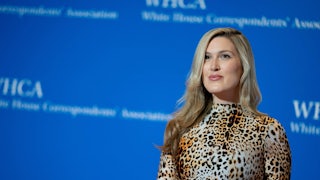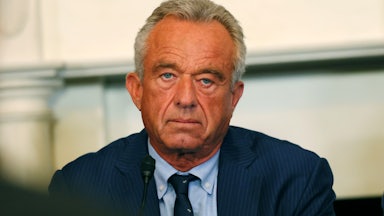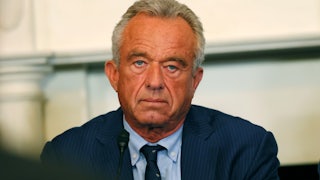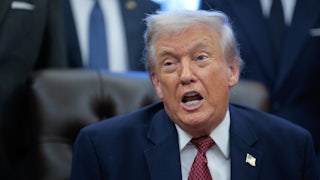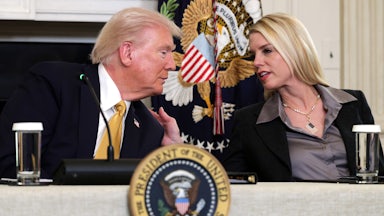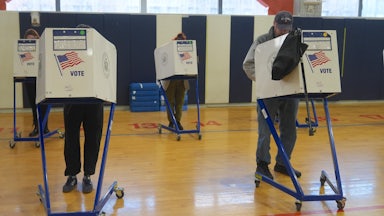You had to go through a metal detector to get to the Children’s Health Defense conference, held in Austin, Texas, on November 7–9, and conversation on the first morning buzzed about it. At the Make America Healthy Again symposium that convened the next week, Health and Human Services Secretary Robert F. Kennedy Jr. and Vice President JD Vance played footsie with officials from Walmart, Google, and a slew of biotechnology firms. But in Austin, there were no administration heavyweights on the agenda.
So, who could be at risk? Could it be Andrew Wakefield, the disgraced British doctor whose bogus research brought forth modern anti-vaccine conspiracies? Del Bigtree, perhaps, the Austin-based podcaster and filmmaker whose 2016 documentary featuring Wakefield positioned him as an equivalent expert when Covid panic exacerbated existing suspicions. Or maybe Russell Brand, uncontested as the most famous name on the schedule but temperamentally unlikely to take himself out of harm’s way. The morning of day two, I saw him walk out the lobby in leopard-print swim trunks and a hotel bathrobe and slippers.
The gracious young woman who let me register as press did not seem to be hiding anything when she told me the security wasn’t in response to a specific threat to a specific person; just, you know, threats.
No one should feel like they’re in danger; people are allowed to respond to vague unease in the way that makes sense for them. On the other side of the metal detectors that I went through was a booth selling pendants and bracelets to protect against EMF radiation (including items for pets).
The fringy edges of the conference are vestiges of the movement’s origins. Today, Kennedy, CHD’s former president, runs the federal government’s most important public health agency. This is a movement that expects big things, and is increasingly getting them: Two weeks after attendees scattered, the studiously ignorant reactionaries Kennedy installed at the CDC replaced language on its website with anti-vaccine talking points, contrary to the long-settled research on whether vaccines cause autism. They don’t. But in the America shaped by Kennedy’s ascent, scientific consensus is no match for anecdote, and policy now emerges from the grief-stricken, the conspiratorial, and the increasingly vindictive.
When the tanned, frizzy-haired woman at my table closed her eyes and gestured up, down, side, side, it was after we’d spent all morning bathed in the anti-vaccine movement’s newly explicit Christian coding (“God is an Anti-vaxxer,” as Del Bigtree put it). But when I tested my assumption by asking why she made the sign of the cross, she wrinkled her brow. “Oh no, it wasn’t that.”
A blessing? I offered.
No, she said—“a clearing.”
The CHD conference was smaller than most political conferences I’ve covered—maybe a thousand people. No breakout panels, just a single main stage. Vendors circled the ballroom like satellites: back braces, nasal sprays, electromagnetic-radiation protectors, small-batch supplements. We sat at banquet tables, not in rows. My tablemates introduced themselves easily, candidly, accepting my role as a reporter with nothing more than a cheerful, “What do you think so far?” I tried to be honest. “It’s a lot to take in,” I’d say, and “I have questions.”
As she dissolved connections, the speakers on the stage kept winding a certain thread tighter: “Republicans need to remember that MAHA moms are why Donald Trump won the 2024 election,” and, “We need collectively to give Bobby Kennedy, a very brave and smart man, the support he needs.” In order to pass the “truckloads of medical freedom bills” they want to, “we need to hold the House.”
“Stick together,” urged Polly Tommey. “Don’t be deceived.”
Mary Holland, CEO of CHD, put it almost regretfully: “This is a nonpartisan movement that has become partisan.”
Humming under the current of celebration (briskly selling Make America Healthy Again hats, reminders that the president himself has a long history of intimating a connection between vaccines and autism) is a thread of insecurity, an acknowledgment that the union between a movement born out of environmental alarmism and another born out of political resentment requires constant mending and refocusing.
The woman who brushed away the poisonous spiderweb was a bit of an outlier at my table on the first day. Next to me was a sparky retired former teacher from Nebraska who told me about the growing number of autistic children she’d see in her classes, echoing the suspicions that animate much of the movement. What could explain this explosion besides a change in the environment? On my other side, a man who introduced himself as a doctor from the Midwest. Our fifth was a female programmer. The conference was heavily dominated by women; most everyone (male and female) I met was a technical professional of some sort. It’s a big “do your own research” community, obviously, but the common thread ran deeper: When attendees were asked for those in the audience to stand up if they had a “vaccine-injured,” half rose to be counted.
The last presentation of the morning was a tour of the anti-vaccine movement’s historical canon by physician Suzanne Humphries. This was, admittedly, difficult to follow; my notes are just full of “!!!!” over and over again. As best as I can recall, among the featured players was a 17-year-old female savant in biochemistry dragooned into research on an injectable cancer that the U.S. government planned to use to kill Castro. At some point in the winding narrative, the CIA had to silence our heroine’s boyfriend by framing him for the murder of the president. And then they had the boyfriend assassinated, after which they killed the boyfriend’s assassin by injecting him with the Castro-killing cancer. You know, as one does! (It was the only time at the conference that a member of the Kennedy clan showed up in the narrative, as a side player.)
You might think it’s a long walk from these stories to the MMR vaccine being primarily responsible for autism and the belief that the Covid pandemic was a full-blown hoax, but Humphries has us covered, constantly circling back to the central spine of all anti-government conspiracies: If they could do this, they can do anything.
Still, movements are sustained by hope, and, sure enough, a living monument to possibility was right there in the room. Introduced from the stage, that aforementioned precocious teenage researcher—Jocelyn Baker Vary—stood to a standing ovation, proof that the government couldn’t silence us all. The doctor at our table leaned over and confided he wanted to write a musical about her. (Incredibly, I later learned there is already such a musical. You can watch a song from Me & Lee, which had a one-day run off-Broadway in 2019.)
When we broke for lunch, the would-be librettist stepped away. I asked the group what they thought of the Baker Vary story. There were some uncomfortable glances. They’d have to look into it some more.
I’ve never been to a political conference that also served free buffets (maybe that was another reason for the security gates). With no one having to leave the area to scavenge for overpriced soggy sandwiches, the intimacy between attendees amplified—and the walls of the echo chamber closed tighter.
I’ve also never been to a political conference that featured the kind of frank personal exchanges I participated in and overheard: People chatted about allergies and “gut issues,” an announcement asked for courtesy to be shown for the EMF-sensitive. Strangers shared home birth tips. I have been to home-schooling conventions where people are more reticent about what goes on behind closed doors. Maybe it’s the nature of vaccines, how they slip under the skin. Maybe it’s the grief. Maybe it’s the metal detectors.
I asked my tablemates about a disconnect between the profound empathy I’d seen for the children they believe to have been harmed by a government program and the then-impending interruption of the Supplemental Nutrition Assistance Program. Both the members of a couple from California who’d joined us shook their heads: “I’m against people going hungry,” the woman said. “It’s a problem politically.” But, her husband interrupted, “I understand most of them live off junk food, anyway.”
I wanted to jump in to point out that junk food is better than no food at all, but the woman wanted to talk about a different injustice: Government-mandated vaccines “hurt Black boys the most.” They have the highest rates of autism in California, she claimed, citing a one-in-12 statistic I couldn’t trace later—though in April, RFK Jr. did announce that “one in 31 American children born in 2014 are disabled by autism” and that the number in California (among all races and genders) was one in 12.5.
“They’re doing this to the poorest kids.” She added one thing I didn’t doubt was true, at least as of the moment: “If you have money, you can keep away from the vaccines.” Her daughter paid a physician to write exemptions, for example. I didn’t get a chance to explain that Kennedy’s CDC was creating an exciting new possibility for the poorest among us to join these exclusive unvaccinated ranks: When they remove vaccines from the federally mandated immunization schedule, neither Medicaid nor private insurance have to cover their cost.
“These children will never be toilet-trained,” another bemoaned. I heard this a lot. (According to the Children’s Hospital of Philadelphia, most people with ASD are capable of independent toileting.)
Why, though? Why make all these kids sick? Why risk all these deaths? “Big Pharma bought off the whole government.”
But, obviously, that could never happen again.
On day two, I sat next to a retired computer engineer from the Pacific Northwest and his wife, a nurse. He was chatty; curious about what I thought and checking in with me after almost every speaker.
“Just trying to learn,” I told him.
“That’s right,” he said. “That’s all we want, a free and fair hearing. It’s the censorship that bothers me.” Twenty-four hours earlier, I’d heard a speaker call for “orange jumpsuits” and criminal charges against the “architects” of the pandemic.
During the EMF panel, my new friend tapped his radiation-blocking phone case and smiled. During the panel on “turbo-cancers,” he took a few notes but acknowledged my eye-roll when panelist Derek Guillory encouraged the crowd to look into “oxidized urine therapy.” Guillory had teased us just prior, “How weird do you want to get?” And went on to suggest fasting as long as possible: “At day 7, if you don’t have a spiritual experience you should come talk to me.”
At a pause in the action, my tablemate offered out of nowhere that he thought the government shutdown was “suicide” for Republicans. “I don’t get why they’re doing it,” he said. I agreed, and he nodded, “I just don’t want you to think we’re all knuckle-dragging right-wingers,” he said.
I told him I definitely didn’t think that. I did wonder who he had voted for.
The last few speakers didn’t keep many people in their seats, so most attendees missed Intellectual Dark Web podcaster Brett Weinstein reporting back on the “elevator experiment” he does at conferences. (This is different from the ongoing elevator experiment where he doesn’t wear a mask.) When he rides up or down, he strikes up a conversation and weaves in that he’s there to discuss “medical freedom” or, if pressed, “vaccine skepticism.”
Here in Austin, he admits that his numbers weren’t looking so good: Out of a handful of conversations, about half were people who immediately expressed some kind of negative reaction. A few were neutral. But, he said, there was one person who wholeheartedly endorsed their worldview. “It was the bellhop!” he exclaimed. Applause. Weinstein admits it’s an unscientific survey. But, he says, they’re convincing more people every day.
It’s an accident that, for once, an anti-vaxxer’s unscientific investigation aligns with the truth. Statistically, there are still more parents vaccinating their children than refusing. More people who believe in vaccines than don’t.
That fact has to be remembered before we give any anti-science a “hearing.” Hearings don’t level the playing field; they legitimize the premise. As “serial entrepreneur” Steve Kirsch bragged, “Today, I am a misinformation superspreader.”
The problem with deeply sincere beliefs rooted in personal experience is that they are nearly impossible to uproot. I suspect some of the marquee speakers could be pried from their anti-vaccine beliefs with a large enough check. The woman I spoke to quit her pharmacist job and took out loans to start a blood bank for unvaccinated people to receive unvaccinated blood. God told her to do that, she said. What evidence could convince her otherwise?
Beating back all of the public health policies this movement has already unraveled will require separating the compassion we may feel for people on a personal level from the ruthlessness that will be required to put our house back in order after this age of Trumpian Lysenkoism passes. Pro-science people have to let results speak for themselves. They always have. Sometimes those consequences just don’t speak as quickly or as loudly as we’d like. Anti-vaccine advocates can point to dead and injured children as often as they want. Under the Trump administration, we might have more of those on our side too.
Right before the close of the weekend, the conference ringmasters invoked the “vaccine-injured” again, this time with a video montage. Sniffles echoed in the half-empty room. A woman at my table sobbed openly.
I resisted the impulse to comfort her.


